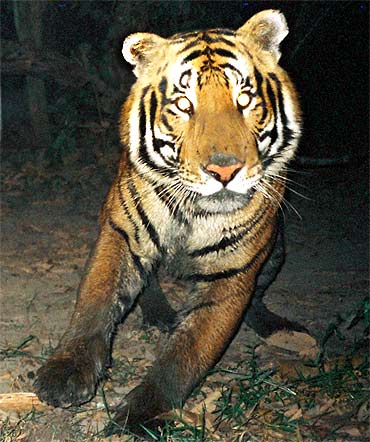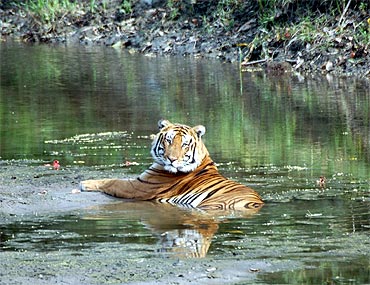Photographs: Aaranyak K Anurag
India registered a 20 per cent increase in tiger population, says a report, the All India Tiger Estimation: 2010, released in New Delhi on July 28. Thanks to sustained conservation efforts, the big cat population in Assam has touched an impressive 143 last year, marking an record increase of 73 from 2006.
Today, the state represents nine per cent of the country's estimated tiger population of 1,706 with 100 tigers living in its forest areas, mostly in the Kaziranga landscape.
The sprawling Kaziranga National Park is a treasure trove of tigers today and wildlife experts say this is because tigers can move easily to nearby protected areas like the Karbi Anglong Hills, the Laokhowa and Buhrachapori Wildlife sanctuaries and the Orang National Park. However, such migration without encountering human settlement is nearly impossible as the forests are dotted with encroachments.
To conserve the tigers in Assam, it is important to gather vital scientific data for better management of tigers and prey animals in the landscape.
On adventurous tiger trail in Kaziranga
Image: Estimated population of 1,706 tigers represents a 20 percent increase from the last survey in 2006Photographs: Aaranyak
Keeping this in mind, Aaranyak, a prominent society for bio-diversity conservation headquartered in Guwahati, was roped in. A scientific and industrial research organisation recognised by the department of scientific and industrial research under the ministry of science and technology, Aaranyak was entrusted with the job of carrying a camera-trap survey of tiger population in a certain area within the KNP in collaboration with Assam forest department. The society is a member of the International Union for Conservation of Nature.
A team from the society, which is member of the International Union for Conservation of Nature, led by senior biologist Dr Firoz Ahmed carried out this exercise in consultation with experts from the Wildlife institute of India and other competent institutions. The objective was to conduct a scientific survey of tigers and its prey animals.
The findings of the study were used in compiling the India Tiger Estimate 2010, which mentions that camera trapping was the primary method used, where individual tigers were identified from photographs based on their unique stripe patterns. This information was analysed using a well- established scientific framework. The camera trapping was carried out by teams of wildlife biologists and local forest personnel.
Dr Ahmed recalling his wonderful experience of trailing the tiger through lenses in Kaziranga said that the national park's well-known status as a high-density tiger area has been further emboldened because of the encouraging findings of the camera-trapping exercise. The outcome of the six-month long exercise in 2009 covering about 112 square km in the core area of the KNP indicated presence of over 32 tigers within 100 square km area.
"The study area was divided into 50 grids each measuring 1.5 square kilemetres. As many as 39 tigers (including a cub aged less than one year) were identified in the camera trapped area," Dr Ahmed said.
Besides Dr Ahmed the other members of the core team involving in trailing the tiger included two other biologists -- Kamal Azad and Ajit Basumatary. The core team is supported by eight staff from the forest department.
The Geographic Information System laboratory of Aaranyak under the leadership of Pranjit Sarma played a big part of this programme. The research officer and other officials of Kaziranga National Park and the range officer of Orang National Park were part of the monitoring programme.
On adventurous tiger trail in Kaziranga
Image: Sign surveys were carried out before cameras were placed in the national park"To find out suitable locations for cameras, areas that are frequented by tigers were identified with sign surveys conducted in selected grids. Signs like pugmarks, scats, scrap marks and kills are always left behind by tigers indicating their presence in an area. We recorded all these signs during road and trail transects. Other than that, signs of prey and other animals were also recorded. The sign survey was conducted by a team of biologists and forest staff from the nearest anti-poaching camp," he informed.
Two cameras (Olympus Stylus 80) were connected to a Trailmaster 1550 Active Infrared Monitor through a multi trigger at each of the selected 50 locations. The two cameras photographed both flanks of the tigers to confirm individual identification. Both the cameras were mounted on steel reinforced box to protect it from large animals like elephants and rhinos and positioned five to six metres away from each other.
The sensor height of the trap was positioned approximately 0.4 m above ground at a horizontal position. The traps were made unobtrusive and as cryptic as possible.
Each camera trap was given a unique number and all locations were finally recorded by a global positioning system and marked on the map. Each film (ISO 200) was given a unique number before it was loaded. The unique number on camera trap and on films helped in tracking vital information at a later stage of data analysis.
All the cameras were set to print the date and time of each exposure thereby enabling accurate information of individual tiger movement. Each exposed and marked rolls were sent to a photo lab for developing separately and carefully.
Printed photographs were used to identify individual tigers. Individuals were identified using differences in stripe pattern on flanks, limbs, tail and forequarter and each of them was given a unique number. The Kaziranga tigers were separated into male, female, unknown sex and cub. Then each of them was numbered individually. For example: KZT_025_M (male), KZT_010_F (female), KZT_038_U (unknown sex) and KZT_039_C (cub).
On adventurous tiger trail in Kaziranga
Image: Density of tigers in Kaziranga has doubled since 1998Photographs: Aaranyak
To minimise avoidance by tigers, we moved the cameras by 50-100 meters every seven to eight days or as soon as such behaviour was noticed. All cameras were monitored daily to record any activity and to verify proper functioning. All data was recorded on a data sheet. A data downloader (trail master TM data collector II) was used to download the events from the trail monitors for future references.
Team members recalled that elephants roaming in the KNP posed a huge hindrance to the camera trap exercise. "Elephants were a major cause of annoyance as every day we would find one or more cameras damaged by them. Rhinos were a cause of concern as well, but not as much as the tuskers," a team member said.
It was a thrilling experience for the Aaranyak team, as they got several opportunities to sight the majestic animal in the wild. Tigers by nature prefer to stay out of sight of human beings and that is why thousands of tourists visiting the KNP every rarely spot a tiger.
Kaziranga's alluvial grassland provides optimal habitats for tigers and the region boasts of the highest density of tigers in the world as shown by Nichols & Karanth (1998). Interestingly, the results of Aaranyak's study showed that the density of tigers has doubled as compared to this last estimation.
According to Nichols & Karanth (1998), Kaziranga has the highest density of large prey animals (16.9 animals/km2) that included wild buffalo and swamp deer. However, the park also harbours hog deer, sambars, rhinos and elephants in relatively good number.
While sambar is a known preferred prey, tigers in Kaziranga also predate on rhinos and elephant calves and also feed on carcasses of rhino that die naturally or are killed by poachers. "During this study we recorded three elephant calves were killed by tigers and surprisingly one of them was four years old. Similarly, swamp deer are also often predated by tigers in the park."
On adventurous tiger trail in Kaziranga
Image: 11 tigers were spotted in Manas National ParkPhotographs: Aaranyak
The methodology followed in Manas was similar to what was employed in the KNP tiger study. In Manas Park, as many as 77 locations were trapped using over 150 camera traps that were spread over 600 sq km covering parts of both in Manas National Park in Assam and Royal Manas in Bhutan.
Dr Ahmed said that nine individual tigers were identified from the photograph obtained from camera traps. The total tiger population estimated in the study area, which is the central and eastern range of the park, was 11. The density estimated was 1.8 tigers per 100 sq km.
The exercise was carried out simultaneously on Indian and Bhutan sides of the contiguous forest area in Manas However, data procured on either side of the international border is yet to be shared to determine overlapping tigers and actual number of tigers in the landscape.
Aaranyak's project for monitoring tigers is sponsored by David Shepherd Wildlife Foundation, United States Fish and Wildlife Service, Rufford Small Grants Foundation, Panthera and SeaWorld & Busch Gardens Conservation Fund Conservation Fund at different stages during 2008-2011.






article